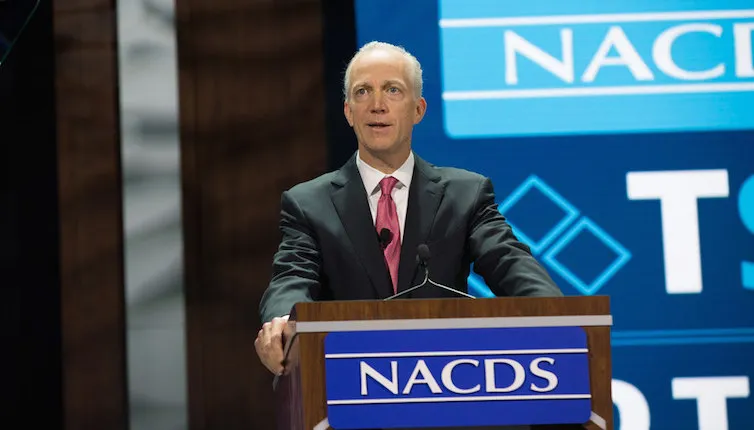
BENTONVILLE, Ark. — A simplified shopping experience with improved navigation and adjacencies is at the heart of Walmart’s over-the-counter drug presentation, says Carmen Bauza, the company’s senior vice president of OTC health care.
The goal is to give customers opportunities to build their shopping basket, explains Bauza, who also oversees optical, baby care, paper goods and household chemicals at Walmart.
“We’re putting together products that are not necessarily based on a category or a department, but are more about being customer-focused and designed around how people shop,” she says. “It’s really not a new concept, but it’s what we’re excited about. It’s being able to truly deliver on the customer’s expectation based on how she shops.”
Exemplifying that approach is Walmart’s presentation of the active nutrition segment, which includes protein bars and powders, and dietary supplements. All those products tend to draw people interested in sports or those with an active lifestyle, notes Bauza, so bringing them together establishes a lifestyle destination.
Improving adjacencies is a challenging task, because space tends to be static, Bauza acknowledges. And such categories as incontinence and feminine care have been juxtaposed even though they’re unrelated.

Carmen Bauza
“It has been a fascinating journey,” she says. “We’re not near where we would like to be in every store. But with new and remodeled stores, you’re seeing more of the adjacencies that we feel are right for the customer.”
The process is much easier in new stores, because merchants are starting from scratch, she adds. Revamping existing stores is a little more difficult. “It does take a little longer. But we’ll get there. And early results indicate that in changing adjacencies we have made the right decision.”
While OTC products are still in front of the pharmacy, they are now positioned as part of a destination for services.
At a new store in Royse City, Texas, for example, the pharmacy, vision center and a clinic are side by side with an OTC/wellness department incorporated into the services experience. And next to the wellness area are beauty and personal care (categories that Bauza ran successfully before taking on OTCs four years ago), “creating that full customer experience,” she says.
“Just based on what we’re seeing so far, it makes a lot of sense for us to be able to create a destination for services,” she comments. “And they’re really health services that can expand beyond just visual and clinics and the pharmacy itself.”
Having OTC/wellness outside the pharmacy creates a one-stop shop so the customer doesn’t have to be inconvenienced with different trips for different categories, Bauza observes. And enhancing that opportunity is Walmart’s increased focus on baby care, especially natural, organic and “free from” or “Clean” products.
The retailer’s product development and private label team helps it understand what constitutes natural ingredients, notes Bauza. “And we work with credible suppliers as well that are bringing those products to market.”
The chain has learned from its grocery business that affordable organics are essential, she remarks. “And that’s where we’re seeing the industry moving. These products are becoming more mainstream. And the more mainstream they become, the more prices come down, which makes them more accessible for any customer that chooses to buy those products. I’m excited to see that part of the business getting the traction that it’s getting.”
In the past Walmart has offered a very limited selection of pediatric products, but now it has them in the OTC and baby departments, which is very convenient for mothers, notes Bauza.
“So if mom is coming in to just pick up her prescription and only has one trip to make, she’s able to find what she’s looking for for her baby in OTC. If she’s here to do grocery shopping, she can find what she needs in the baby department, near grocery,” she says. “So because of the size of our box, sometimes dual placement of certain products makes it much easier for a customer, and creating that convenience is very important to us.”
Also important is private label, which Walmart will continue to give private label a prominent role, according to Bauza, She says Walmart probably has less store brand penetration than any other of its retail competitors.
“Where there is the opportunity, we will continue to expand private label,” she comments. “That’s part of our strategy, and we’ll continue to offer that.”
Walmart positions its private label OTC products as value alternatives to national brands, as well as trying to be an innovator — to be a brand in its own right.
“First and foremost, we’re going to make sure that we offer quality at a value,” Bauza remarks. “And value doesn’t mean that we are just offering the cheapest thing we can find, because sometimes that’s probably not a good proposition if you want to really offer innovation.”
Generally, buzz is increasing in the OTC space, Bauza adds. “There are some exciting things going on this space. This business is kind of cyclical. Sometimes you see the innovation dwindling a little bit, and then you see it spike up again. I feel that the next couple of years are going to be really great for innovation. And we know that every time that happens, it’s a guarantee that we will have a great year in OTC.”








